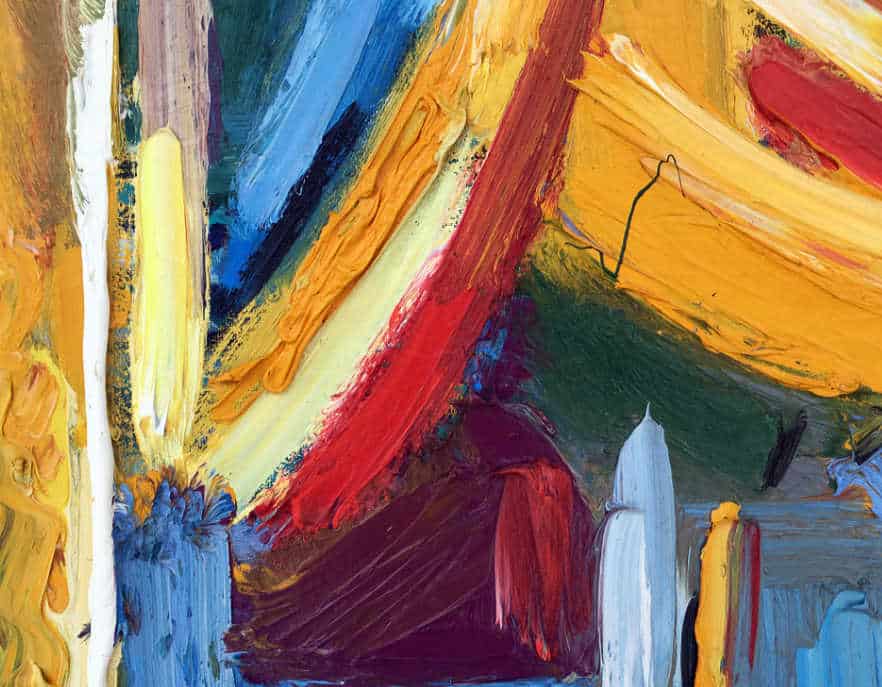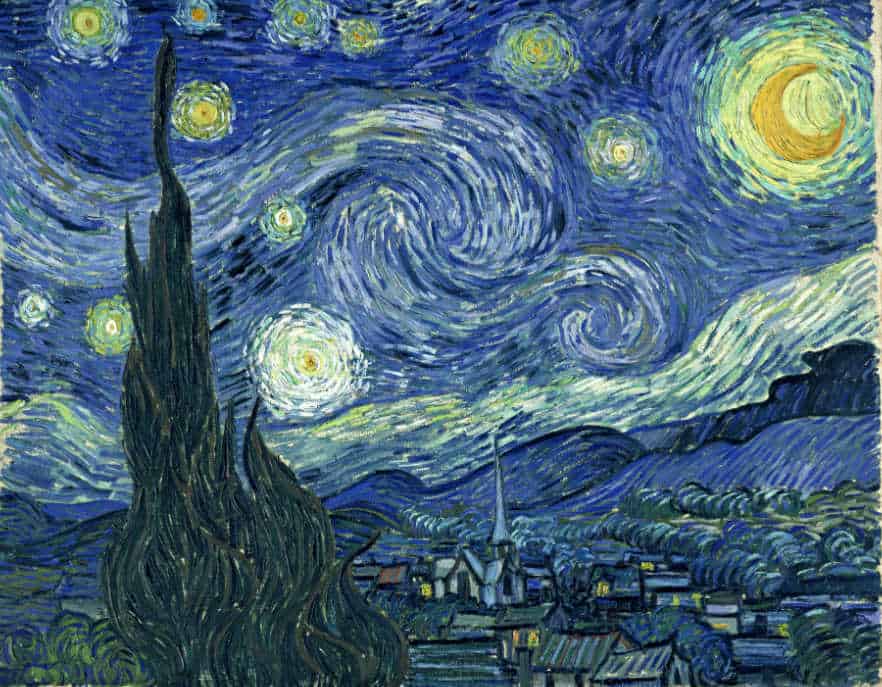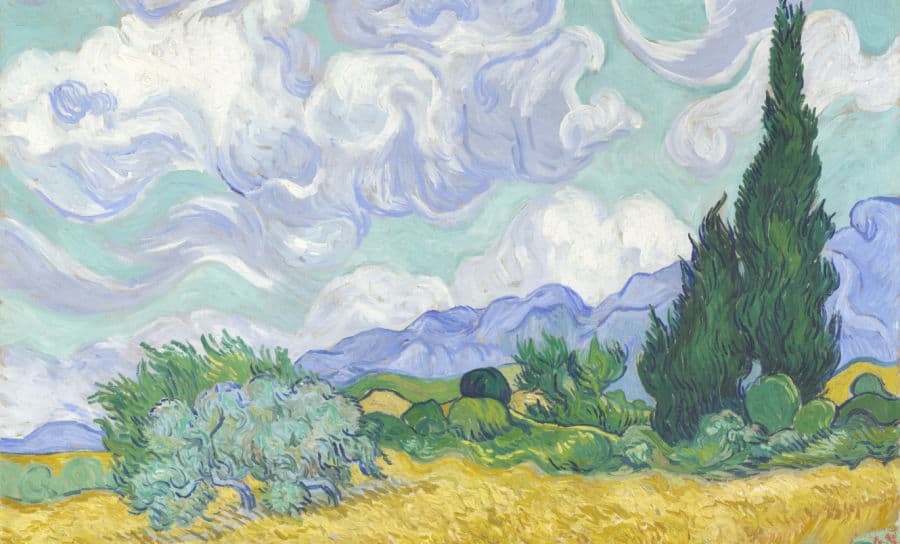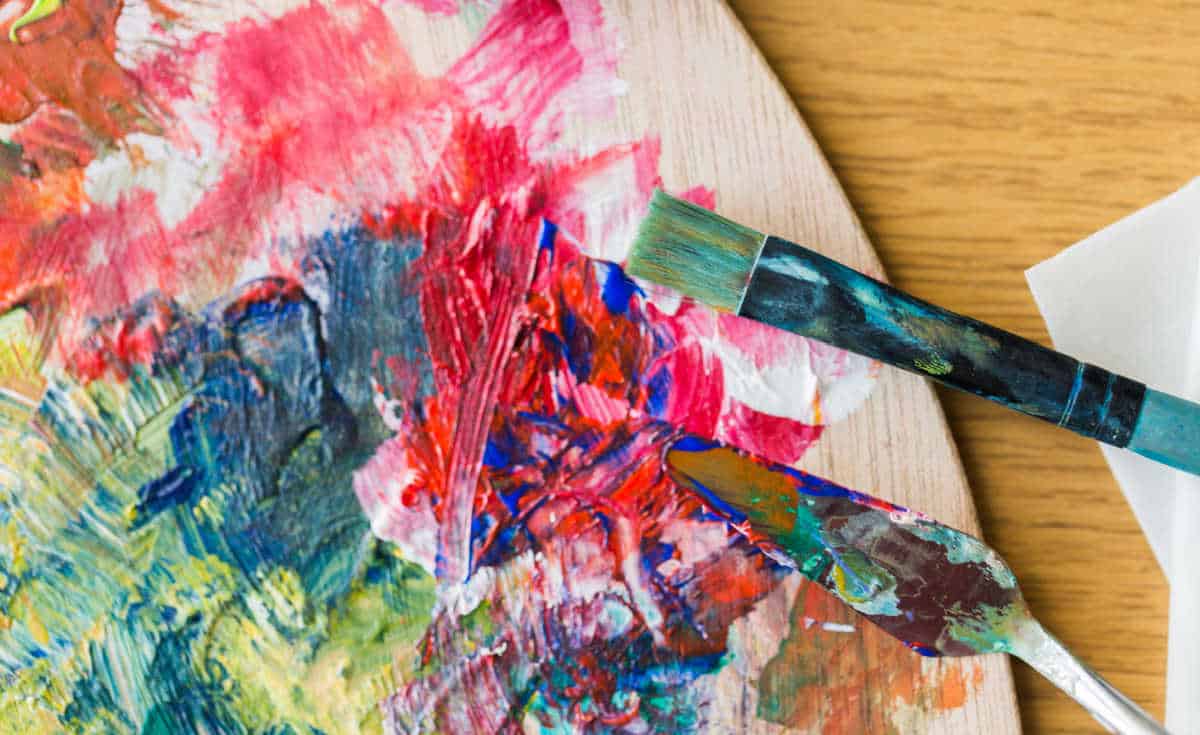Impasto, from an Italian word meaning dough, is a painting technique where thick layers of paint are applied to a canvas or surface, creating a three-dimensional texture that is visually striking.
The Impasto painting process produces visible brush strokes and knife strokes. The paint is applied in a way that it stands out from the surface, giving the artwork a textured appearance that can be felt by touch.
This technique is in contrast to traditional painting methods where paint is usually applied in thin, smooth layers.
The impasto effect is traditionally an oil painting technique but can be used in acrylic painting as well. Thinner paints such as watercolors are not ideally suited to this technique.
This post may contain affiliate links. If you click a link and buy, I may receive a small commission. Please see my full privacy policy for details.

History of Impasto
Impasto, as a painting technique, has a rich history that spans various art movements and periods. Here’s a brief overview of its evolution:
During the Renaissance, the first use of impasto is thought to have been in works by the Venetian Renaissance artists Titian and Tintoretto. They began using Impasto to enhance their oil paintings. They used thicker paint to create dramatic effects, capture light, and add texture to their subjects.
The Baroque period saw the use of impasto to create dynamic and textured surfaces in portraits and clothing. Baroque painters like Peter Paul Rubens used impasto to bring a tactile quality to their works.
Impasto gained prominence during the 19th century when artists used thick, textured paint to capture the play of light and atmosphere in their landscapes and scenes. Artists such as Joh Constable used the Impasto technique to capture the untamed, rough terrain of rocks, soil, and cliffs with an experimental and energetic flair.
In the 19th century, the artist Vincent van Gogh employed impastos in a remarkable manner, constructing and delineating shapes within his paintings through the application of thick, energetic strokes of paint. Artists such as Vincent van Gogh used impasto to convey emotion and intensity in their works.

The Abstract Expressionist movement, led by artists like Jackson Pollock and Willem de Kooning, embraced impasto as a way to express their inner emotions and create powerful, abstract compositions.
Impasto remains a popular technique in contemporary art, with artists using it in both traditional and experimental ways. The development of new materials and mediums has expanded the possibilities for creating textured surfaces.
Throughout its history, impasto has evolved from a technique to add texture and dimension to a powerful tool for conveying emotion, movement, and energy in art. Its influence can be seen in various artistic styles and movements, making it a technique that continues to be appreciated and practiced by artists today.

Benefits of Using the Impasto Technique
Using the impasto technique in art offers a range of benefits that contribute to the visual and emotional impact of a piece. Here are some key advantages:
Enhanced Texture: Impasto creates a tactile quality that engages the viewer’s sense of touch. The raised paint layers add a three-dimensional texture to the artwork, making it visually intriguing and physically engaging.
Visual Depth and Dimension: The thick layers of paint used in impasto give the artwork a three-dimensional look. This can make the subjects in the painting appear more lifelike and immersive.
Emotional Expression: The bold and textured strokes of impasto can convey emotions more vividly. Artists can use the technique to evoke feelings such as passion, energy, intensity, and movement.
Dynamic Lighting Effects: Impasto allows artists to play with light and shadow, as the raised surfaces catch the light differently from the flat areas. This can create dramatic contrasts and enhance the illusion of light sources within the painting.
Unique Style: Incorporating impasto into your artwork adds a distinctive style that sets your pieces apart. The texture and depth achieved through impasto can become a signature element of your work.
Experimentation: Impasto encourages artists to experiment with different tools, techniques, and materials. This experimentation fosters creative growth and leads to the discovery of new artistic possibilities.
Versatility: Impasto can be used across various artistic styles, from realistic to abstract. It can be applied to various subjects, such as landscapes, portraits, and still lifes, allowing artists to explore different themes and genres.
Historical Connection: Impasto has a rich history in art, with renowned artists from different periods employing the technique. Using impasto connects contemporary artists to this lineage and adds a sense of tradition to their work.
Focal Points: The raised surfaces created by impasto can draw the viewer’s attention to specific areas of the artwork, helping to emphasize focal points or important elements within the composition.
Expressive Potential: Impasto provides artists with a versatile means of expression. It can be used to create a wide range of effects, from intricate details to bold, sweeping gestures.
In essence, the impasto technique offers artists a unique and versatile way to elevate their work, infusing it with texture, emotion, and visual interest. Its ability to add depth, energy, and tactile quality to paintings makes it a valuable tool in an artist’s toolkit.

Materials Required to Create an Impasto Painting
To create an Impasto painting, you’ll need specific types of paint and supplies that are well-suited for the Impasto painting technique. Here’s a list of the essential materials:
1. Paints
Oil Paints: Oil paints are a traditional choice for impasto due to their slow drying time, which allows for more manipulation of the thick paint.
Heavy Body Acrylic Paints: These are thicker and have a higher viscosity compared to regular acrylics. They hold their shape well when applied with impasto painting techniques.
2. Brushes
Stiff Bristle Brushes: Use brushes with stiff bristles to handle the thick paint and create various textures. Hog hair brushes are a popular choice for this purpose.
3. Palette Knives
Palette knives are indispensable for impasto. They allow you to apply, shape, and manipulate the thick paint on the canvas. Different shapes and sizes of palette knives can produce various effects.
4. Mediums (Optional):
Some artists choose to add impasto medium or impasto gels to their paint to further enhance the texture and body of the paint or to speed up drying time. These can be mixed with the paint to achieve thick consistency or brushed directly onto the painting surface with a painting knife to add texture.
You can also purchase various mediums, gels, and additives to thicken acrylic paint or add more texture.
5. Canvas or Painting Surface
Stretched canvas or a sturdy painting surface is necessary to support the weight of the thick paint. A thicker canvas or wood panel is preferable to prevent sagging or warping since Impasto applications can be quite heavy.
6. Easel (Optional)
An easel provides a stable and adjustable platform for your canvas, allowing you to work comfortably at the desired angle.
7. Solvents (for Oil Paints)
If you’re using oil paints, you may need solvents like turpentine or mineral spirits for cleaning brushes and thinning paint if necessary.
Remember that the specific brands and materials you choose can vary based on your personal preferences and the effects you want to achieve in your Impasto paintings. Experimenting with different paints, tools, and techniques will help you develop your own unique style with Impasto.

How to Make an Impasto Painting
Achieving an impasto effect in a painting involves applying thick layers of paint to the canvas or surface to create texture and depth. Here’s a step-by-step guide to the impasto technique:
1. Prepare Your Canvas:
Start with a stretched canvas or a sturdy painting surface. Ensure it’s clean and primed if necessary. Impasto paintings tend to be much heavier than regular paintings because of the thickness of the paint. A heavy impasto painting can cause sagging in your canvas so it is best to use a good quality canvas that is stretched tight or a canvas board or wood panel.
2. Select Your Paints:
Choose heavy-bodied acrylic paints or thick oil paint. These paints have a thicker consistency and work best for impasto.
3. Set Up Your Workspace:
Place your canvas on an easel or a flat surface at a comfortable height. Ensure good lighting and ventilation in your workspace.
4. Mix Your Paint:
Squeeze out the paint colors you need onto your mixing palette. You can mix colors on the palette to achieve your desired shades or mix them directly on the canvas.
5. Use Palette Knives:
Palette knives are the primary tools for applying impasto. Dip the palette knife into the paint and lift a generous amount of paint onto the blade.
6. Apply Paint with the Palette Knife:
Apply the paint directly to the canvas with the palette knife. You can use various techniques:
– Scraping: Drag the palette knife across the canvas to create flat, textured areas.
– Dabbing: Dab the paint onto the canvas to create raised, textured spots.
– Layering: Apply multiple layers of paint to build up texture and depth.
7. Experiment with Strokes:
Experiment with different strokes, angles, and pressures to create varied textures and effects. You can achieve smooth, controlled areas and bold, textured sections.
8. Mixing on Canvas:
Impasto allows you to mix colors directly on the canvas. Apply one color next to another and use the palette knife to blend them together. This creates visually interesting color transitions and effects.
9. Build-Up the Layers:
Continue adding layers of thick paint to build up the desired texture and dimension. Let each paint layer dry before adding more if you want to maintain distinct layers.
10. Clean Your Tools:
Periodically clean your palette knife or switch to a new one to prevent colors from blending unintentionally.
11. Fine-Tune Details:
Once the impasto areas are in place, you can use brushes or finer tools for detailing and refining specific parts of your painting.
12. Allow to Dry:
Depending on the thickness of your paint layers, impasto paintings may take longer to dry than traditional paintings. Be patient and allow ample drying time.
13. Varnish (Optional):
After your Impasto painting is completely dry, you may choose to apply a varnish to protect the surface and enhance the colors of your finished work.
Remember that impasto is a technique that encourages experimentation and creative freedom. Feel free to explore different tools, layering methods, and color combinations to achieve the desired texture and visual impact in your artwork.

Tips for Beginners
If you’re a beginner looking to try your hand at impasto painting, here are some tips to get you started:
Start with Small-Scale Projects:
Begin with smaller canvases or surfaces to practice impasto techniques before tackling larger works. This allows you to get comfortable with the process without feeling overwhelmed.
Use the Right Paints:
Choose heavy-bodied acrylic paints or oil paints. These paints have a thicker consistency that works well for building up texture.
Experiment with Texture:
Don’t be afraid to experiment with different textures and effects. Try using various palette knives, brushes, or even your fingers to create unique textures in your impasto areas.
Mix Colors on Canvas:
One of the advantages of Impasto is the ability to mix colors directly on the canvas. Use this to your advantage to create interesting color transitions and variations.
Layer Gradually:
Build up your impasto layers gradually. Allow each layer to partially dry before adding more paint. This prevents colors from blending excessively and maintains distinct textures.
Clean Tools Regularly:
Keep your palette knives and brushes clean. Impasto paintings often involve mixing colors directly on the canvas, so cleaning your tools ensures that unwanted colors don’t mix unintentionally.
Consider Composition:
Think about the composition of your painting. Decide which areas will benefit from impasto texture and which should remain smoother for balance and contrast.
Be Patient with Drying Time:
Impasto paintings can take longer to dry due to the thickness of the paint. Be patient and avoid touching or varnishing until the paint is fully dry to prevent smudging.
Learn from Others:
Study the work of artists who excel in impasto techniques. Analyze their use of texture, color, and composition for inspiration and guidance.
Enjoy the Process:
Impasto painting is a tactile and expressive technique. Embrace the process, and don’t be afraid to make mistakes. Many happy accidents can lead to beautiful and unexpected results.
Practice, Practice, Practice:
Like any art form, impasto improves with practice. Keep experimenting, learning, and refining your skills to develop your unique style.
Remember that impasto is a versatile and expressive technique, and there’s no one “right” way to do it. Have fun exploring and discovering your own approach to Impasto painting.
Famous Artists and Some of Their Impasto Works
Impasto has been effectively used by many renowned artists throughout art history. Here are some notable Impasto painters and their artworks that showcase the effective use of impasto:
Vincent van Gogh:

Van Gogh is perhaps one of the most famous practitioners of impasto. Van Gogh’s paintings, such as “Starry Night” and “Wheat Field with Cypresses” are known for their bold, swirling textures and expressive use of thick paint.
Rembrandt van Rijn:

Rembrandt’s portraits, like “Self-Portrait with Two Circles,” demonstrate his masterful use of impasto to create rich, tactile surfaces and play with light and shadow.
Claude Monet:

Monet’s Impressionist masterpieces, such as “Water Lilies,” showcase his skill in using impasto to capture the fleeting effects of light and atmosphere on water and landscapes.
Eugène Delacroix:

Delacroix’s “Le Combat” employs impasto to create a sense of energy and movement in the figures.
Delacroix’s distinctive artistry was defined by his free-flowing impasto technique, marked by the liberal application of thick, weighty layers of paint.
Frank Auerbach:
A contemporary artist, Auerbach’s portraits and cityscapes are notable for their thick impasto and intense, textured surfaces.
Willem de Kooning:
De Kooning, a prominent Abstract Expressionist, used impasto to create dynamic and emotionally charged compositions, as seen in works like “Excavation.”
Chaim Soutine:

Soutine’s expressionist paintings, like “Les maisons,” are known for their heavily textured surfaces and raw, emotional intensity.
These artists demonstrate the versatility of impasto, using it to convey a wide range of emotions, capture the essence of various subjects, and create textured surfaces that engage the viewer on multiple levels. Studying their works can provide valuable insights into the effective use of impasto in art.




I have been asked to paint a ceiling tile for a hospital’s breast cancer ward. This will be something that is uplifting and/or calming to the patients as they receive their chemo treatments. I am quite nervous about this project due to the fact that a normally use watercolor paints. I started to research other types of paints like oil and acrylic due to the weight and consistency of the material. I ran across your article here. I am interested in your thoughts about using different types of paints (possibly with some sort of additive) to create a visually appealing piece. The material is quite bumpy and has like small holes in it so I am concerned most about that. Could you give me some ideas/thoughts of tackling a project of this nature. I would greatly appreciate it.
Nancy Moore
Hi Nancy,
What a wonderful and very worthwhile project! I have painted on ceiling tiles before. Don’t be intimidated. You can thin acrylic paint with water or a medium such as Liquitex Matte Medium to make the acrylic paint seem more like watercolor. Work with the texture and holes. Remember that it will be seen from a distance so the holes will not be very noticable. Use an acrylic varnish over the piece once it dries to protect it from dust and dirt. The nice thing about acrylics is that if you don’t like the finished product, you can use gesso to cover it up and start again. Maybe practice your painting on a canvas or textured paper first. I hope this helps. 😊
Thank you so much Marilyno for all the information about impasto painting techiques. This is so nice of you and I appreciate you very much for the work you do for us to improve our passion of creating beautiful art work. I have been looking for you forever and you make us feel so good about ourself. I am Lucille from Canada and again thank you. Feel free to do whatever you want to do with my comments if this will help more painters with Disease. Sorry about my spelling I am French but fluent as well with English but not my spelling lol lol
Thank you for the article it is very informative. I’m wondering if the composition is outlined first?
Hi Wanda; It depends on what style of painting you are doing (ie: abstract) but it is a personal preference. You can certainly outline the composition first if you are more comfortable doing it that way.
Your information about impasto painting is wonderful! I have been looking for books about the technique and found none as yet. Maybe your website, trembelingart.com, will have some suggestions. Thanks